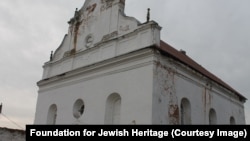Historian Simon Schama and the creator of the popular television series Downton Abbey, Julian Fellowes, will be joined by dozens of other high-profile Jewish writers, politicians and actors in the British House of Commons Wednesday to launch a Europe-wide project aimed at preserving and restoring as many as 160 ruined pre-World War II synagogues.
The rebuilding project is backed by a Jewish foundation that since 1979 has been mapping the 17,000 synagogues that were active in Europe before World War II. Only 3,318 of the buildings still stand and of those, just 718 remain functioning as places of worship. The others have fallen into ruin or are now being used as warehouses, factories and theaters. One is a fire station and some have been converted to dwellings.
Campaign organizers acknowledge that they can’t save all the synagogues they would like to, but plan to restore the most important.
“We’ve homed in on 160, and narrowed those down to 19 that we’re particularly looking at, where there’s a good chance of saving and restoring the buildings,” Michael Mail, a member of the Foundation for Jewish Heritage, a Britain-based non-profit organization, told The Guardian newspaper.
The foundation, which teamed up with the Center for Jewish Art at the Hebrew University of Jerusalem to map the synagogues, says, “The annihilation of the majority of Jewish communities in Europe during the Holocaust was accompanied by mass destruction of synagogues, and the remaining buildings were left mostly without care. Especially pitiful was the fate of former synagogues in eastern Europe under Communist rule: they were demolished, reconstructed for various purposes or simply abandoned.”
In western Europe, “the state of preservation was significantly better” but “small Jewish communities were unable to maintain numerous synagogues,” the foundation says. Campaign organizers say they are in a race against time and that their restoration effort will not only help to preserve Jewish heritage, but Europe’s cultural heritage as well.
Among the synagogues being earmarked is the Great Synagogue in the town of Slonim, which is now in Belarus. It was built in a Baroque style between 1635 and 1642.
At the start of World War II, the town was in Poland and captured by the Red Army, which killed hundreds of Jews, labeling them counter-revolutionaries. In 1941, Slonim was captured by the German Wehrmacht and Jews were quickly targeted by the Nazis, whose mobile extermination squads slaughtered hundreds. The first large-scale extermination of Jews took place on July 17, 1941, when some 1,000 Jews were shot and buried in mass pits on the outskirts of a nearby village.
A second mass murder of the town’s Jews occurred on November 14, 1941, when 9,000 people were transported to pre-dug pits on the outskirts and shot by rifle fire. The Great Synagogue survived the war, but 10 smaller ones, known as Stiblach, did not. The Great Synagogue was used after the war as a warehouse, but has been abandoned for two decades.
According to the foundation, “For the Jewish people with traditions built on memory, such places give meaning to the Jewish present and future, strengthening awareness and connection. They are also testimony to the remarkable Jewish contribution to world civilization; powerful visual tools for education on Judaism, Jewish history and culture promoting understanding, respect and dialogue.”
Another synagogue designated for restoration is a Gothic-style one in the Welsh town of Merthyr Tydfil, built in the 1870s mainly by Jews from eastern Europe. The building was used for some years as a Christian hall and then a gym, but is now derelict.
Campaigners say they hope to attract donations for the restoration from wealthy individuals as well as from other heritage groups and contributions from governments.
The launching of the restoration project comes at a time of rising fears about a resurgence in Europe of anti-Jewish sentiment. Last week, Pope Francis called on European countries to do more to fight anti-Semitism, saying indifference on the issue was a virus that could allow racial hatred to spread.
In January, Germany’s lower house of parliament voted for the creation of a new government post to oversee the fight against anti-Semitism, following the burning of Jewish symbols and Israeli flags. Several European countries have reported an alarming rise in anti-Semitism, including Poland, where in November during a far-right march in Warsaw, some protesters brandished anti-Jewish banners. In Sweden last month, a synagogue was fire-bombed.
And this month, a community group which monitors hate crime in Britain said anti-Semitic hate crimes are on the rise there and had hit a record high. Britain’s Jewish community was targeted at a rate of nearly four times a day in 2017, according to the Community Security Trust, which said it had recorded 1,382 anti-Semitic incidents last year, the highest tally since it started collecting data in 1984.










